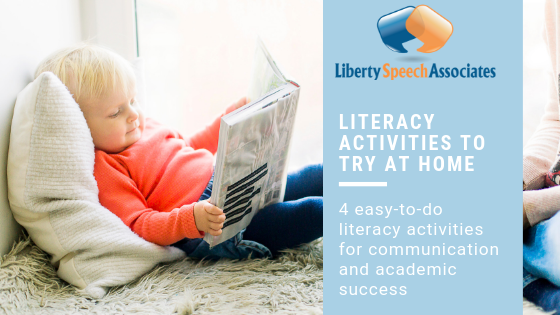In honor of Dr. Seuss’s upcoming birthday, I thought I’d do a post about literacy activities. Did you know that a child’s exposure to books greatly impacts his/her communication and academic skills? Through this post, I hope to share some easy-to-implement literacy activities. These activities will help your child improve his communication, vocabulary, and literacy skills.
4 Easy Literacy Activities
1. Engage your child in rhyme
There is probably no one more famous than Dr. Seuss when it comes to rhyme. Take, for example, one of his most popular books, The Cat in the Hat. There are rhymes abound on every page. Keep in mind, though, you don’t just have to rely on Dr. Seuss or other rhyming books to encourage or develop this skill. Aside from books, other great tools to encourage rhyme are nursery rhymes and children’s songs. Whether it be a familiar story or song, try pausing at crucial parts to see if your child can fill in the appropriate word (e.g., The cat in the _____).
2. Use wordless picture books
Have you ever heard of a wordless picture book? If not, it’s exactly as it sounds. It’s a picture book with absolutely no words. Now, I’m sure you’re wondering how a book with no words could encourage literacy development, but hear me out. By using wordless picture books, children can practice making up their own stories and developing narrative skills that are so important for both understanding and telling stories. If the idea of telling a story is new to or difficult for your child, you can make up the story first and then give your child a turn. Two great books that I use in therapy are The Boy, the Dog, and the Frog by Mercer Mayer and Pancakes for Breakfast by Tomie DePaola.
3. Have a letter/word scavenger hunt
Who doesn’t love a good scavenger hunt? Scavenger hunts are activities I use a lot in therapy because many different skills can be practiced while allowing children to run around and have fun. If your child is just beginning to learn and recognize letters, see if she can find specific ones when you’re out at the grocery store or driving in the car. This is a game my son absolutely loves. If your child is learning to read words, you look for familiar words in books, magazines or even on food containers (e.g., the cereal box).
4. Role play your favorite story
Does your child have a story or book that he makes you read over and over and over again? I know mine sure does. Whether it’s your child’s favorite book or one that is fairly new, use role play to bring the story to life. For some children, sitting for a story can be a difficult task, so by bringing puppets or costumes into the mix you can grab their attention. There are many story kits you can buy to accomplish this task, but I suggest looking for things you already have around the house to act out the story. The more you and your child use your imaginations, the better the learning experience will be!
This is certainly not an exhaustive list of literacy activities, but I hope it’ll get your mind thinking of other ways you can engage your child in the magical world of story. For some more inspiration, visit Seussville.


